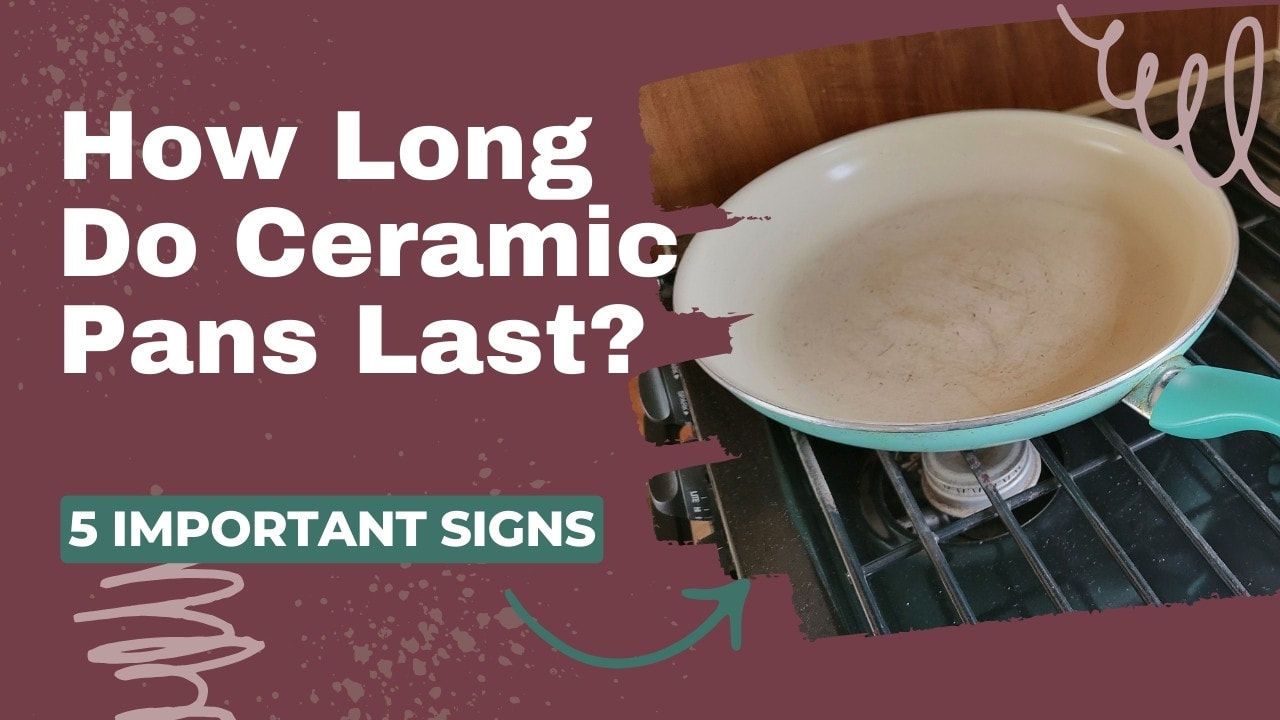When we say “ceramic cookware,” we mean metal pans (often made of aluminum) with a nonstick ceramic coating. It’s a very different technology from traditional ceramic pots made of pure clay, and it’s exploded in popularity among home chefs in recent years.
With ceramic cookware, you get a lightweight pan with a nonstick coating that’s made with natural silica instead of Teflon. It seems almost too good to be true. But the million-dollar question is, “How long do ceramic pans last?” Will they stay nonstick long enough to be worth the purchase?
I’ve used ceramic-coated pans since GreenPan first came to America in 2007.
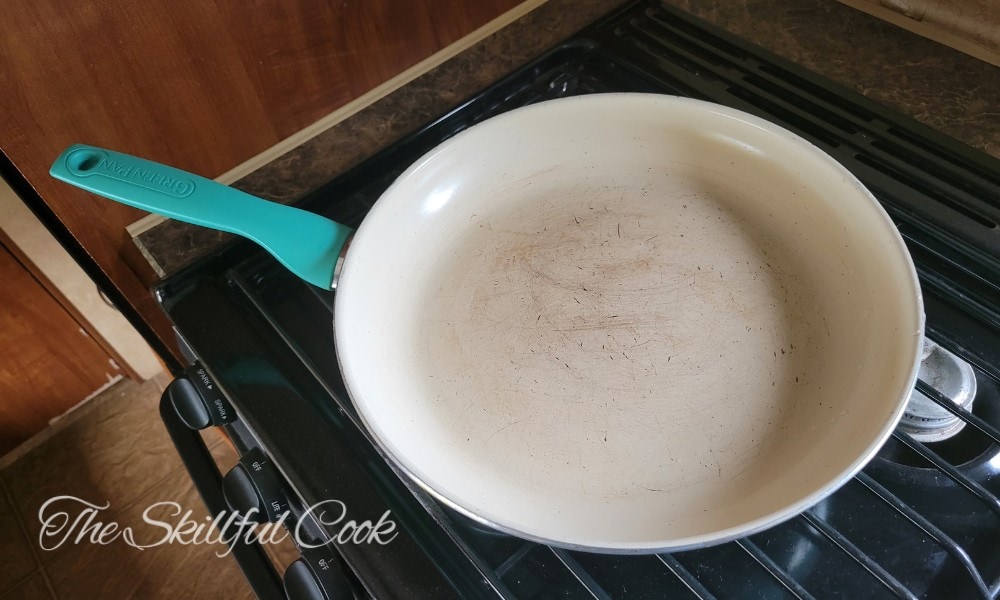
Since that time, ceramic coatings have gotten significantly better. But, sadly, compared to stainless or carbon steel, ceramic pans still feel like semi-disposable pieces of cookware.
How Often Should You Replace Your Ceramic Pans?
On average, ceramic cookware needs to be replaced every 2-3 years, depending on how it’s used. Cooking over high heat or using metal utensils or abrasive cleaners will reduce its lifespan. These pans are not heirloom cookware items you will pass down to your children, no matter how carefully you use them.
Make sure to read the fine print on any warranties that you get with ceramic pans because the guarantees on the coating often expire after 2 years – even if the pan body has a “lifetime” warranty.
5 Signs You Need To Replace Your Ceramic Pans
1. Warping
You may be able to work with or even fix a pan that’s slightly warped, especially if it just bows a bit when it heats up. But if it’s very warped, it’s time to replace it. Warped ceramic cookware will probably have micro-cracks in the coating. Warping may lead to burned or unevenly cooked food. More importantly, a warped pan may spin on flat cooktops or spill, creating a hazard.
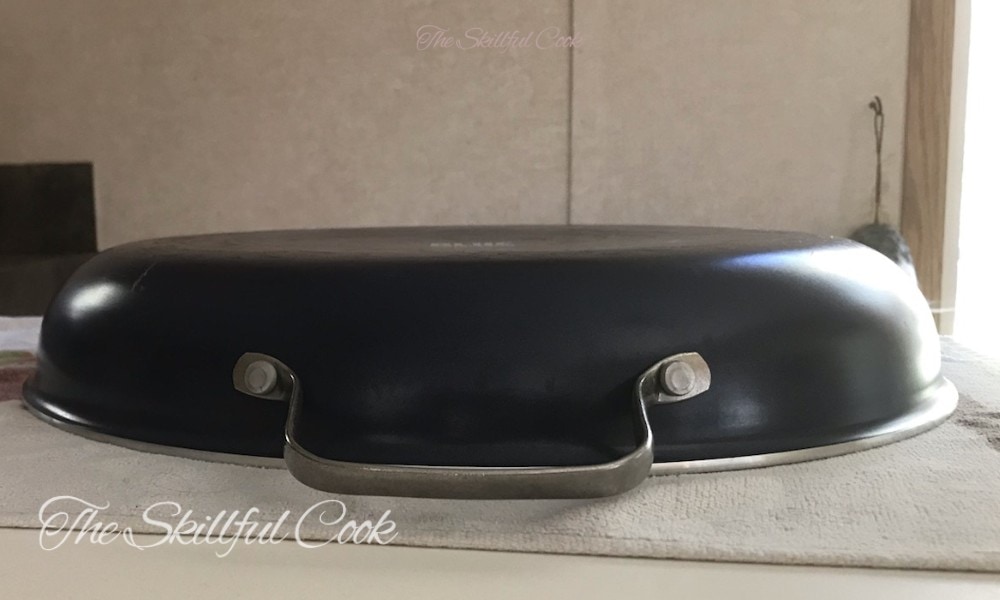
2. Loose Or Rusty Handles
If you can’t tighten the handle, or it begins to rust around the rivets, you should get rid of the pan. You don’t want to risk dropping hot food on yourself due to a faulty handle.
3. Sticking Food
Chances are the reason you have nonstick ceramic cookware is so that food won’t stick to it. When the pan stops being nonstick, it means the ceramic coating has worn down and developed micro-cracks, making the pan more porous. It’s only going to get worse, and more stuck on food just makes the cookware harder to clean.
4. It’s Hard To Clean
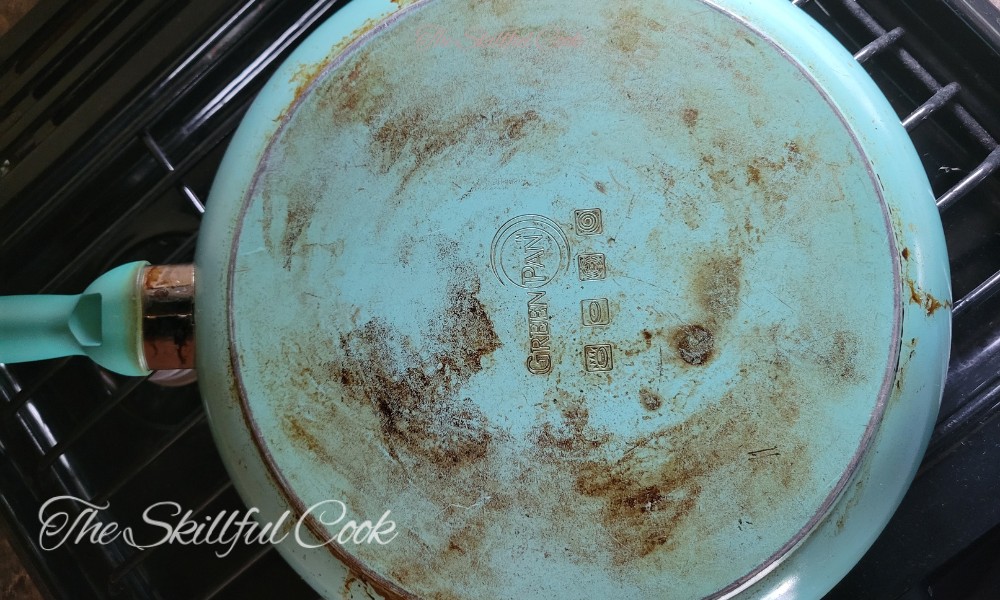
A nonstick pan that is difficult to clean is on its last legs. The more you scrub away stuck or burnt food, the more of the coating you’ll rub off as well. Bacteria are more likely to grow on rough surfaces or those coated with carbonized food bits.
5. Scratches Or Chipping
There’s debate about whether or not scratched ceramic pans are safe to use. I’ve researched this question extensively, and to the best of my knowledge, the answer is that nobody really knows. Ceramic coatings are made with a technology called sol-gel, derived from silica. This technology is relatively new and hasn’t been thoroughly studied.
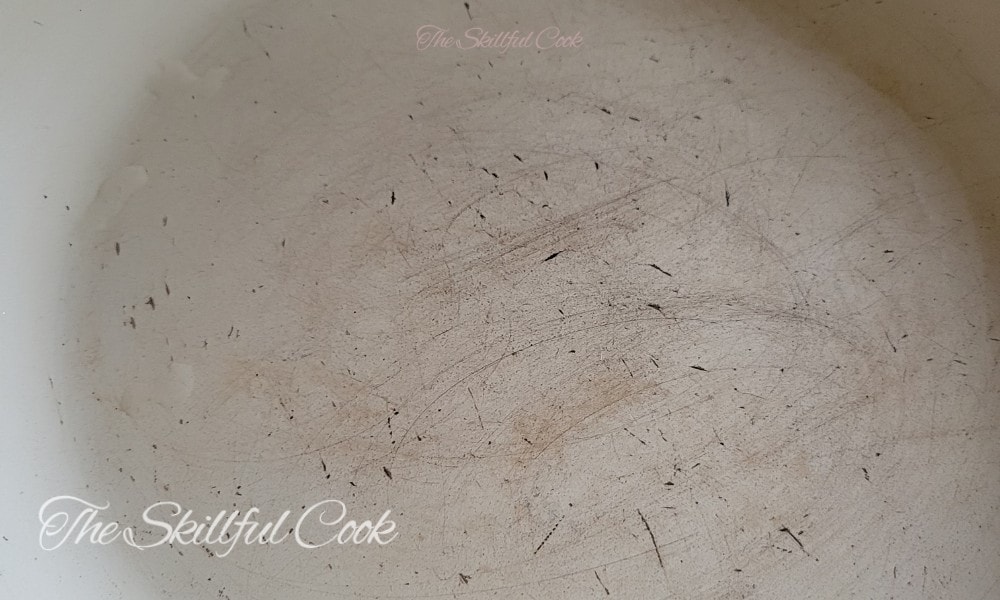
Chances are that a scratched or chipping ceramic pan is generally safe to use, but there are a few potential concerns. One study indicates that titanium nanoparticles used in ceramic coating are more likely to transfer to your food in scratched pans. Another potential concern is if the coating is scratched so far as to expose the pan’s aluminum substrate. More on this below.
Why Do Ceramic Pans Lose Their Nonstick Ability?
Almost every brand of ceramic pans includes a promise of durability in its name and marketing. Maybe it’s infused with diamond dust, titanium, or granite. But, unfortunately, these additives don’t extend the life of the pan very much. The real question is the number of layers of coating and how well it adheres to the metal substrate. Harsh conditions or cooking techniques will cause all ceramic pans to lose their nonstick ability, no matter how well-made they are.
High Heat
Nothing breaks a ceramic coating down faster than high heat. I saw proof of this when food started to stick to my mom’s Blue Diamond pan in a ring around the center of the pan that exactly matched the size and shape of the electric burner she used it on.
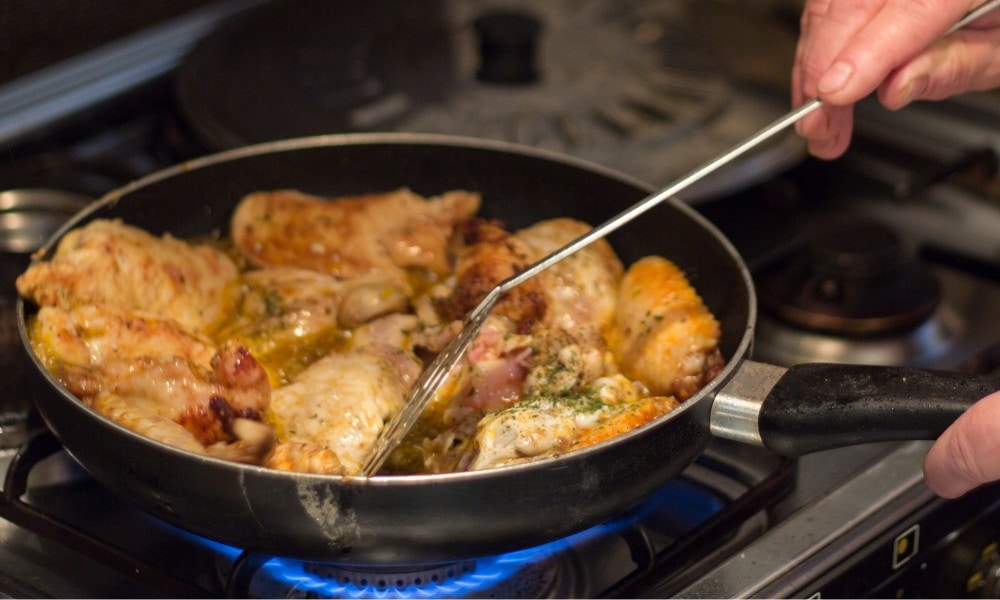
This is because “ceramic” cookware isn’t actually coated in clay, like traditional ceramic. It’s coated in something called “sol-gel,” a silica-based spray that hardens when cured. Sol-gel has organic additives that can break down under high heat, and high temps can induce changes in the crystallinity of the silica coating itself. Like the metal body of the pan, the coating will expand and contract with temperature changes, but it may not expand and contract at the exact same rate as the pan it’s attached to. This will stress the coating.
Thermal Shock
I’ve been tempted to run a smoking hot pan under cold water so many times – but this can be fatal for any kind of cookware! If a hot pan cools too rapidly, it can suffer thermal shock, cracking the ceramic and warping the aluminum substrate.
Using Cooking Oils with a Low Smoke Point
Unrefined cooking oils with a low smoke point, or those that are high in polyunsaturated fats will polymerize easily. This means that – especially if applied in a very thin layer as from a cooking spray – they may cure or harden as a sticky brown film on your pan. This will make food stick, and it may take harsh cleaners to get it off. If nothing else, the elbow grease required to remove polymerized oils from your pan creates a risk of scratching the coating.
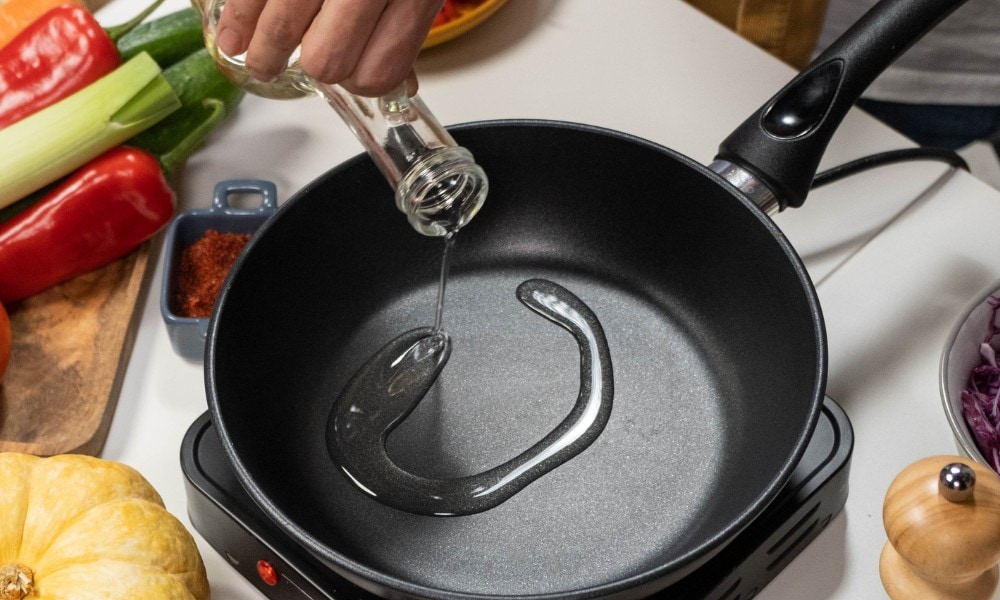
Dishwashers and Harsh Cleaning Agents
Harsh soaps, acid-based cleaners like Bar Keepers Friend, and abrasive pads spell bad news for ceramic cookware. Dishwashers are worst of all. Many ceramic cookware brands market their products as being dishwasher-safe, but if you read the fine print, they’ll plead with you to hand-wash your pans. Just one trip through the heat and scrubbing of a dishwasher is enough to significantly shorten the life of a ceramic pan.
Are Scratched Ceramic Pans Safe To Use?
Sol-gel ceramic coatings on cookware are considered “generally safe” by most experts. Sol-gel is sand-based, which seems harmless. However, we have no way of knowing what colorants, chemicals, or materials may be added to the sol-gel formula to make the pans more durable or more non-stick.
Some cookware brands openly share their 3rd party testing results to show their compliance with California Prop 65, a long list of banned chemicals known to cause health issues. Unfortunately, most ceramic-coated cookware manufacturers don’t test or release the results of testing. If a brand is hesitant to disclose the materials they use in their coating, you may want to avoid that cookware.
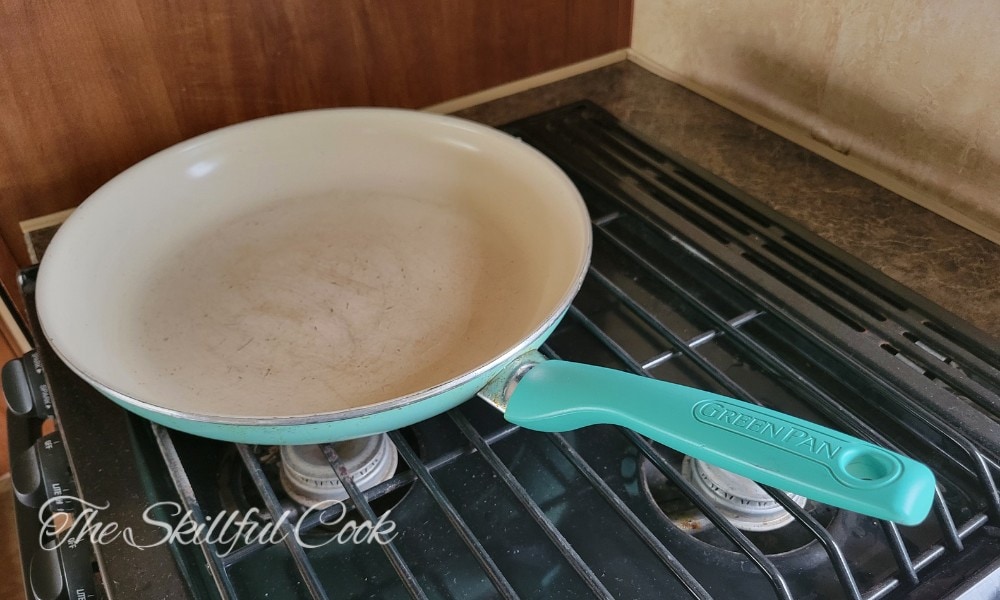
For the sake of practicality, I personally don’t throw away a ceramic pan if it’s just lightly scratched. But if it has deep chips or scratches, I replace it to be safe. Since these pans scratch so easily, I use my ceramic pan very occasionally and very gently. I turn to stainless steel for the majority of my everyday cooking.
Learn more about the safety of ceramic cookware with our detailed analysis.
How Long Does Ceramic Cookware Last Compared To Other Types?
Ceramic cookware is wonderfully nonstick, but it’s nowhere near as durable as other types of pans. Enameled cast iron or seasoned carbon steel are fairly nonstick if handled correctly, and they can last a lifetime.
How does ceramic cookware compare to Teflon-based nonstick pans? It varies. The average life expectancy for top-quality Teflon or hybrid cookware (like Hexclad) is 3-7 years. But low-end Teflon pans may wear out after 1-2 years – or even several months of hard use.
And, in case you were wondering, there
| Cookware | Life Expectancy | Nonstick Ability |
|---|---|---|
| Ceramic Coated (High End) | 2 – 4 years | Excellent |
| Ceramic Coated (Low End) | 6 mos. – 2 years | Good (Needs some oil) |
| PTFE (High End) | 3 – 7 years | Excellent |
| PTFE (Low End) | 6 mos. – 2 years | Excellent |
| Hybrid (e.g. Hexclad) | 3 – 10 years | Good (Needs some oil) |
| Enameled Cast Iron | decades | Fair (Needs oil) |
| Carbon Steel | decades | Fair (Needs oil) |
| Stainless Steel | decades | Poor (Nonstick at high heat with oil) |
| Pure Ceramic (Xtrema) | 10 – 15 years | Good (Needs some oil) |
What’s The Difference Between Ceramic Coated And Pure Ceramic Cookware?
Unlike ceramic-coated cookware, which has a sol-gel coating over a metal core, pure ceramic cookware is made totally of clay, much like stoneware. Xtrema is one of the few brands that makes pure ceramic cookware that is safe for stovetop use and is rated very highly for both its durability and performance.
Pure ceramic cookware is both more expensive than ceramic coated, but it should also last longer. It’s more prone to thermal shock but much less prone to scratching.
Tips for Making Ceramic Pans Last Longer
Frequently Asked Questions
What Are The Disadvantages Of Ceramic Pans?
Ceramic pans are less durable than other types of cookware. Ceramic-covered aluminum is more prone to warping and scratching than high-end Teflon or hybrid pans. These pans can’t go in the dishwasher or be used on high heat, or the coating will degrade even faster. Warranties typically only last a couple of years.
Why Does Food Stick To Ceramic Pans?
Food typically sticks because the ceramic coating on the pan is wearing out. When it’s brand new, you may be able to cook on your ceramic pan without oil. But using a small amount of oil or butter on a ceramic pan from the beginning may help preserve the coating. Food may also stick if the cooking temperature is too high or too low.
Do Scratched Ceramic Pans Need To Be Replaced?
Deeply scratched or chipped ceramic pans should be replaced immediately. They can harbor bacteria in the damaged areas. If the coating flakes off into your food, it could be risky to ingest. If the pan is scratched down to the bare metal, it may leach aluminum into your meal.
Do You Need to Replace Warped Ceramic Pans?
You should replace warped ceramic pans. They may heat unevenly, creating hot spots that will scorch your food. Warped pans may also slide or cause a spill that could hurt someone or create a mess in the kitchen. Pans that return to normal when cooled but warp every time they’re heated are the most dangerous. A pan that warps while full of hot oil could spatter and cause burns or a kitchen fire.
Conclusion: Are Ceramic Pans Worth The Investment?
So, since they don’t last very long, why do I keep a ceramic pan in the kitchen?
I use it for hash browns, fish filets, and other delicate foods that need to be cooked on low heat and stick like-the-dickens to stainless steel. I also use it for anything that needs to be cooked with very little oil or fat.
I think that a ceramic pan is worth the investment if you use it wisely. But if you use it for every meal, you’ll have to replace it frequently – which means a strain on the wallet and a lot of cookware going to the landfill. Thankfully, there’s a great alternative to ceramic-coated cookware in Xtrema’s pure ceramic.
What do you think? Are ceramic pans worth the investment? Do you have other questions? Drop us a comment!

